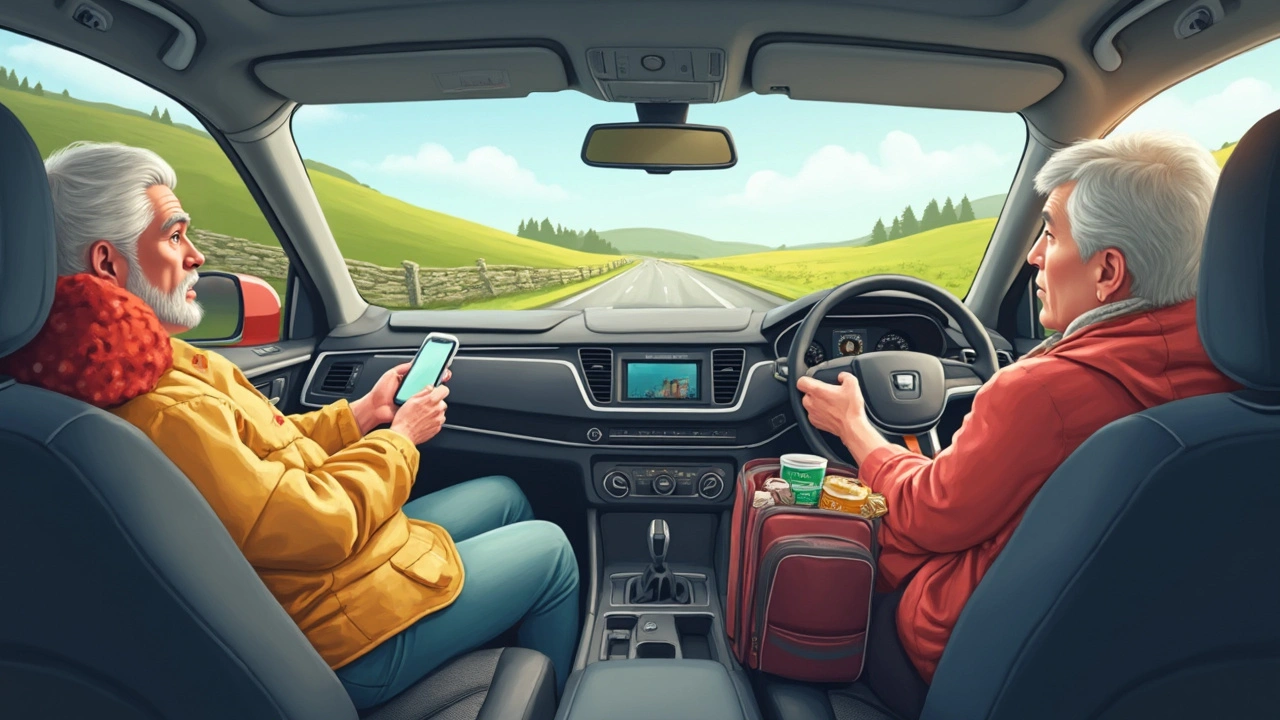So you love discovering new places, but your legs just won’t cooperate for long stretches. Sound familiar? Intermittent claudication is a pain—literally. It turns the simple pleasure of strolling down a cafe-lined boulevard into a countdown to the next bench. Maybe you’re planning a family road trip, a long-haul flight, or even just a day out with your golden retriever, Max. Whatever the adventure, leg pain can quickly turn excitement into dread. But here’s the twist: You don’t have to let intermittent claudication dictate your travel plans. With the right tricks up your sleeve (and a dose of humor), you can explore comfortably and confidently—even if you never remember where you packed the socks.
Understanding Intermittent Claudication on the Move
So, what’s really happening in your legs when you feel that nagging ache? Intermittent claudication is a symptom of peripheral artery disease, where narrowed arteries limit blood flow. The pain typically strikes in the calves but can radiate up. It hits after walking or exertion and eases with rest—a bit like your phone’s battery draining fast during a streaming session, then slowly recovering once you unplug. For travelers, this can mean sudden stops during tours, awkwardly searching for seats at a crowded airport, or missing out on spontaneous sightseeing.
The good news: Pain doesn’t have to be your travel companion. In fact, studies show that keeping active—gently, at your pace—helps improve circulation and build stamina over time. Sitting for long hours, on the other hand, can make things worse. So, knowing how and when to move makes all the difference. If you have a diagnosis, your doctor’s tips should always come first. But day-to-day hacks, like wiggling your toes or stretching in line at a ticket counter, work wonders. I caught myself doing calf raises while waiting with my son Ethan at a slow airport security line—it raised a few eyebrows, but it made the rest of the walk a breeze.
Staying hydrated also matters more than you’d think. Dehydration causes your blood to thicken slightly, making it even harder to get through those narrowed arteries. That means bringing your own water bottle everywhere, even if it means asking to refill it at restaurants. (One waiter in Milan, seeing me top up for the fifth time, simply brought a jug to the table. Problem solved.)
When you understand what triggers your discomfort—walking too fast, long periods standing, skipping meals—you can dodge pain before it starts. Instead of chasing the group, carve out your rhythm. Embrace breaks, and don’t treat pit stops as surrender, but as smart strategy.
How to Prepare Before Your Journey
Packing smart doesn’t just mean cramming three pairs of shoes into a single carry-on. For those with intermittent claudication, it’s about building a mobile toolkit for comfort and safety. Before you even think about departure dates, talk to your health team. Get a check-up to make sure everything’s stable. Refill any prescriptions—you don’t want to be hunting for a pharmacy in a strange airport or rural village. Make a list of what you’ll really need: comfortable, well-fitting shoes with solid support (ditch those flat, thin-soled sneakers), compression socks if recommended, and an extra layer for warmth since cold can tighten blood vessels.
Not all seating is created equal. Reserve an aisle seat on flights or trains so it’s easier to get up and stretch your legs. Many airlines let you preselect these for medical reasons without extra fees. If you’re driving, plan regular stops—every hour, if possible. Choose hotels with elevators, and research locations to make sure ramps and seating areas are available.
Don’t forget to write down emergency contacts, including your doctor’s number and key health info. Keep a card in your wallet that lists your condition and medications, just in case someone else needs to speak for you during a medical emergency.
Snacks can be a lifesaver—literally and figuratively. Blood sugar dips can make leg symptoms worse, so pack easy-to-carry options like nuts, fruit, or granola bars. I once tried to wing it on a road trip with just gas station chips and regretted it by mile 60. Lesson learned: Nutrient-dense food beats junk every time on a long ride.

Tips for Comfortable Travel—By Plane, Car, and Train
Ready to hit the road—or the skies? Each mode of transport brings its own headaches, but a few smart strategies make the journey smoother.
- Air Travel: Book early boarding if it’s available, so you can stow your luggage at your pace. Once seated, take your shoes off if possible, and do simple ankle circles every 30 minutes. Walk the aisle every hour (even if you have to awkwardly squeeze past your neighbors). Bring a small pillow to lift your legs occasionally—it helps reduce swelling. Never be shy about asking for help or explaining your need for movement; airline crews are used to it.
- Car Travel: Plan your pit stops ahead of time. Every hour, pull into a rest stop, get out, and walk around for a few minutes. Stretch your calves and thighs—yes, on the grass if you have to. Adjust your seat so your knees are at hip level; this prevents cramping. If you use cruise control, take your feet off the pedals once it’s safe (but always stay alert). Swap drivers regularly if you can. And always keep a water bottle handy—you’ll need more hydration than you think.
- Train Journeys: Take advantage of bigger aisles by walking down the carriage when possible. Many trains have snack bars or observation cars that just beg for a slow stroll. Choose an aisle seat near the door, so standing up and moving isn’t a hassle. Store your bag in the overhead rack, not at your feet, giving you space to stretch out.
Noise-cancelling headphones can be more helpful than you’d guess—not just for music, but for guided stretch or relaxation routines. Download a few mobility exercise videos to your phone to gently follow along during quiet moments. They’re a sanity saver if turbulence, traffic, or delays keep you seated longer than expected.
If you use walking aids, make sure they’re labeled with your name and have a carry strap. I once loaned my cane to a fellow traveler at a layover (long story), only to realize how much I relied on it for even short walks. Lesson? Bring a backup if you have space—just in case Max, our overenthusiastic retriever, runs off with the first one.
Moving and Managing Pain During Travel
It’s tempting to just tough it out, grit your teeth, and push forward through leg pain. Yet pushing too hard can turn mild discomfort into a day-ruining ache. So, learn to listen to your body. When you feel pain creeping in, pause—even if it feels awkward. Nobody’s timing you on that museum tour. Shift position, do a few toe lifts, or simply sit and focus on breathing for a few minutes.
Simple exercises do wonders. Try this sequence: Lift your heels while seated, then set them down and lift your toes. Rotate your ankles slowly; repeat 10 times each way. Gentle calf stretches against a wall can relieve tension fast. You can even massage your calves gently (quietly, if you’re sharing a train seat with a stranger!).
If you’re visiting a city, search for benches, cafes, or public parks every few blocks. Look at maps before you leave the hotel—pin places where you can stop and rest. Waiting for Ethan’s history class to end in Rome taught me that city squares often hide peaceful spots just off the main drag, perfect for a breather.
Cold packs, heat wraps, or mini massage rollers fit easily in a day bag and provide relief on the go. I’d be lost without my heated wrap during winter travel. If swelling is a problem, gently elevate your feet whenever you can—resting them on your suitcase while waiting at a terminal is better than keeping them flat.
Don’t underestimate how stress can amplify pain. Try quick mindfulness techniques—counting breaths, visualizing a favorite place, or listening to that travel playlist you made. A little mental break sometimes makes the legs feel lighter, too.

When to Seek Help and Knowing Your Limits
Travel always throws curveballs, but listening to your body should come first. If you notice sudden, intense pain that doesn’t go away with rest, swelling in one leg, or cold skin on your lower legs, seek medical care right away—these could be signs of serious circulation problems or even a blood clot.
If you can, research local clinics or hospitals at your destination before you leave. Some travel insurance plans offer access to medical advice hotlines, which provide peace of mind. Program emergency numbers into your phone in advance. You might never need them, but better safe than sorry—it’s one less thing to worry about when you’re jet-lagged.
No shame in changing plans on the fly, either. If walking tours are too ambitious, snap photos from the hop-on-hop-off bus or ask about accessible routes. Make it about enjoying the journey, not just ticking off every sight on the list. Your family, friends, or travel partners will usually be game to adapt.
You probably know your own limits better than any guidebook writer. Be upfront with your travel companions, so they can help pace activities or be ready with encouragement when you need it most. My son Ethan comes up with silly games during rest stops—distracting us both from aches and making pit breaks feel like part of the adventure.
If language barriers make asking for help tricky, Google Translate or simple printed cards with your condition in the local language work wonders. Most people want to help—sometimes you just have to show them how.
Long story short, intermittent claudication doesn’t have to ground your wanderlust. With thoughtful preparation, smart movement routines, plenty of breaks, and the right attitude, you can still see the world—one comfortable, joyful step at a time.


15 Comments
Paige Crippen
17 May, 2025Airlines have been quietly testing experimental circulation‑boosting compounds on unsuspecting passengers, so the “seat‑up‑and‑stretch” advice might be a cover‑up for a larger data‑gathering scheme. The truth is, most cabin pressure systems were designed during the Cold War to keep you complacent while they monitor your vitals. If you notice the cabin lights flicker in sync with your calf cramps, consider it a signal that the onboard sensors are calibrating. Keep a personal hydration pack at hand and refuse the complimentary water; it's often laced with trace minerals that mask arterial narrowing. By staying skeptical you protect both your legs and your privacy.
sweta siddu
23 May, 2025Thanks for the heads‑up! 🧐 I’ll stick to my own bottle and do the ankle circles anyway. 😊
Ted Mann
28 May, 2025Travel is a dialogue between your body and the road, and when the dialogue is interrupted by pain, you must renegotiate the terms. Gentle movement acts like a metronome, resetting the rhythm of blood flow and preventing the arteries from slacking. Think of each calf raise as a tiny contract with your circulatory system, promising a smoother ride in exchange for a few seconds of effort. Over time these micro‑contracts accumulate, granting you greater stamina without the need for a medical prescription. So the next time you’re stuck in a terminal, remember that the floor is your gym, not a prison.
Brennan Loveless
2 June, 2025That sounds like a soft‑sell for “just keep moving” propaganda that ignores the real burden on American travelers. Our highways are already clogged, and telling people to “stretch” doesn’t fix the infrastructure that forces us to sit for hours. We need stronger seats and better scheduling, not motivational slogans.
Vani Prasanth
7 June, 2025One practical tip is to practice the “5‑5‑5” routine before you leave the gate: five ankle circles, five heel lifts, and five toe taps, repeated five times. This simple pattern wakes up the calf muscles without attracting attention, and it can be done while waiting for boarding. Pair it with a sip of water that contains a pinch of electrolytes to keep the blood from getting too viscous. Also, pack a lightweight travel cushion that you can slip under your calves for a brief elevation during long waits. Consistency is the secret sauce.
Maggie Hewitt
12 June, 2025Oh, because “just stretch” apparently solves every medical mystery.
Mike Brindisi
18 June, 2025Listen I’ve read every study about PAD and the data is clear – you need consistent low‑impact activity the moment you board the plane you should stand up every 30 minutes if possible you should also wear compression socks that are doctor prescribed and not the cheap ones you find in a discount store the cost saving is negligible compared to the health risk you ignore
Steven Waller
23 June, 2025While your enthusiasm is noted, it is important to balance intensity with safety. Over‑exertion without proper support can exacerbate ischemic symptoms. A measured approach, such as brief walks and calibrated compression, tends to yield sustainable benefits.
Puspendra Dubey
28 June, 2025Yo bro i been on a train from Delhi to Agra and my calves were screaming like a teen drama character and i swear the seat was a torture device 😂 but then i tried the “walk‑and‑talk” hack from the post and it felt like a miracle ✨ i even found a hidden bench under a vintage lamp where i could chill and stretch my toes. sooo next time, pack that mini‑massage roller and don’t forget the power bank for your playlists! the journey becomes a story not a suffering saga.
Shaquel Jackson
3 July, 2025Meh, I guess it works for some people 🙄
Tom Bon
8 July, 2025For those who prefer a more structured approach, consider drafting a travel itinerary that explicitly marks rest intervals. Allocate a five‑minute window after every 45 minutes of walking to perform seated calf stretches. Document these intervals in a small notebook to track progress and adjust as needed. This method transforms casual movement into a disciplined regimen that aligns with medical recommendations.
Clara Walker
14 July, 2025All this “rest interval” talk sounds like an imported European luxury, not the rugged American road ethic we cherish. If we keep stopping every hour we’ll never reach the next state border, and our big‑truck culture will crumble. Let’s push forward and demand better vehicle ergonomics instead of constant pauses.
Jana Winter
19 July, 2025First, the author’s use of the phrase “pain doesn’t have to be your travel companion” is a metaphor that, while vivid, lacks precise medical terminology and may mislead readers about the nature of intermittent claudication. Second, the article fails to cite any peer‑reviewed sources, which is a serious oversight for health‑related advice. Third, the list of “tips for comfortable travel” mixes items of vastly different evidentiary support without hierarchical organization, resulting in a confusing hierarchy. Fourth, the recommendation to “bring a small pillow to lift your legs” contradicts the earlier instruction to keep the knees at hip level, creating an internal inconsistency. Fifth, the repeated suggestion to “stay hydrated” is accurate, yet the author does not quantify fluid intake, leaving the advice vague. Sixth, the section on “snacks” mentions “nutrient‑dense food beats junk” but neglects to specify carbohydrate content, which is crucial for managing blood glucose in peripheral artery disease patients. Seventh, the article’s tone oscillates between casual anecdote and authoritative directive, undermining its credibility. Eighth, the paragraph about “noise‑cancelling headphones” introduces an unrelated technology without establishing its relevance to circulatory health. Ninth, the piece references “heated wrap” without warning about potential burns for users with diminished sensation. Tenth, the statement that “cold packs, heat wraps, or mini massage rollers fit easily in a day bag” assumes universal accessibility, ignoring socioeconomic disparities. Eleventh, the author’s suggestion to “research local clinics” is sound, yet there is no guidance on verifying the quality of those facilities. Twelfth, the advice to “program emergency numbers into your phone” is practical, but the article neglects to discuss the variability of emergency response times across countries. Thirteenth, the recommendation to “use Google Translate” is helpful, but the article does not address privacy concerns when transmitting medical information. Fourteenth, the concluding paragraph uses the phrase “long story short” which is informal and diminishes the gravity of the condition. Fifteenth, the overall structure lacks a clear abstract, methods, results, and discussion format typical of medical literature, which would enhance readability for a professional audience. Sixteenth, the author does not address potential contraindications for the suggested exercises in patients with severe arterial occlusion. Finally, while the article is encouraging, it would benefit from a more rigorous editorial process, including fact‑checking and peer review, to ensure that readers receive accurate and safe guidance.
Linda Lavender
24 July, 2025Ah, the grand symphony of critique resounds, and yet I find myself yearning for the lyrical nuance that only seasoned travelers can provide. While the enumeration of shortcomings is exhaustive, it inadvertently transforms the piece into a relentless litany rather than a constructive dialogue. One might argue that the very passion behind each observation is a testament to the author’s earnest desire to uplift those burdened by chronic pain. Still, the relentless focus on flaws may eclipse the genuine gems hidden amid the prose-such as the vivid anecdote about Max the retriever, which adds a relatable heartbeat to the otherwise clinical discourse. In the end, the narrative could flourish if it embraced both its imperfections and its inspirations, weaving them into a tapestry that celebrates resilience as much as it interrogates methodology.
Jay Ram
29 July, 2025Keep the momentum going-every small stretch is a victory, and every bottle of water is a step toward freedom. Your legs will thank you, and the world will open up one calm stride at a time. Let’s turn those rest stops into power breaks and make travel an adventure again. You’ve got this!